Development of a Label-Free Electrochemical Aptasensor for the Detection of Tau381 and its Preliminary Application in AD and Non-AD Patients’ Sera
Abstract
1. Introduction
2. Experimental
2.1. Reagent and Chemicals
2.2. Apparatus
2.3. Fabrication of Carboxyl Graphene/Thionin/Gold Nanoparticles Nanocomplex
2.4. Electrochemical Detection of Tau381
2.5. Human Serum and Ethics
3. Results and Discussion
3.1. Morphological Characterization of the Carboxyl Graphene/Thionin/Gold Nanoparticles Electrode Surface
3.2. Electrochemical Characterization of the Aptasensor
3.3. Optimization of Effective Parameters for Aptasensor Response
3.4. Determination of Tau381
3.5. Selectivity, Reproducibility, and Stability
3.6. Application in Analysis of Human Serum Samples
3.7. Analysis Performance of Tau381 Aptasensor in Non- and Alzheimer′s Disease Patient Samples
4. Conclusions
Author Contributions
Funding
Acknowledgments
Conflicts of Interest
References
- Escosura-Muñiz, A.; Plichta, Z.; Horák, D.; Merkoçi, A. Alzheimer’s disease biomarkers detection in human samples by efficient capturing through porous magnetic microspheres and labelling with electrocatalytic gold nanoparticles. Biosens. Bioelectron. 2015, 67, 162–169. [Google Scholar] [CrossRef] [PubMed]
- Brier, M.R.; Gordon, B.; Friedrichsen, K.; McCarthy, J.; Stern, A.; Christensen, J.; Owen, C.; Aldea, P.; Su, Y.; Hassenstab, J.; et al. Tau and Aβ imaging, CSF measures, and cognition in Alzheimer’s disease. Sci. Transl. Med. 2016, 8, 338–366. [Google Scholar] [CrossRef] [PubMed]
- Patterson, C. World Alzheimer Report 2018: The State of the Art of Dementia Research: New Frontiers; Alzheimer’s Disease International (ADI): London, UK, 2018. [Google Scholar]
- Shui, B.; Tao, D.; Florea, A.; Cheng, J.; Zhao, Q.; Gu, Y.; Li, W.; Jaffrezic-Renault, N.; Mei, Y.; Guo, Z. Biosensors for Alzheimer’s disease biomarker detection: A review. Biochimie 2018, 147, 13–24. [Google Scholar] [CrossRef] [PubMed]
- Leuzy, A.; Cicognola, C.; Chiotis, K.; Saint-Aubert, L.; Lemoine, L.; Andreasen, N.; Zetterberg, H.; Ye, K.; Blennow, K.; Höglund, K.; et al. Longitudinal tau and metabolic PET imaging in relation to novel CSF tau measures in Alzheimer’s disease. Eur. J. Nucl. Med. Mol. Imaging 2019, 46, 1152–1163. [Google Scholar] [CrossRef] [PubMed]
- Mielkea, M.M.; Hagen, C.E.; Xu, J.; Chai, X.; Vemurie, P.; Lowee, V.J.; Aireyd, D.C.; Knopman, D.S.; Roberts, R.O.; Machulda, M.M.; et al. Plasma phospho-tau181 increases with Alzheimer’s disease clinical severity and is associated with tau- and amyloid-positron emission tomography. Alzheimer’s Dement. 2018, 14, 989–997. [Google Scholar] [CrossRef]
- Tuerk, C.; Gold, L. Systematic evolution of ligands by exponential enrichment: RNA ligands to bacteriophage T4 DNA polymerase. Science 1990, 249, 505–510. [Google Scholar] [CrossRef]
- Ellington, A.D.; Szostak, J.W. In vitro selection of RNA molecules that bind specific ligands. Nature 1990, 346, 818–822. [Google Scholar] [CrossRef]
- Krylova, S.M.; Musheev, M.; Nutiu, R.; Li, Y.; Lee, G.; Krylov, S.N. Tau protein binds single-stranded DNA sequence specifically—The proof obtained in vitro with non-equilibrium capillary electrophoresis of equilibrium mixtures. FEBS Lett. 2005, 579, 1371–1375. [Google Scholar] [CrossRef]
- Lisi, S.; Fiore, E.; Scarano, S.; Pascale, E.; Boehman, Y.; Ducongé, F.; Chierici, S.; Minunni, M.; Peyrin, E.; Ravelet, C. Non-SELEX isolation of DNA aptamers for the homogeneous-phase fluorescence anisotropy sensing of tau Proteins. Anal. Chim. Acta 2018, 1038, 173–181. [Google Scholar] [CrossRef]
- Guo, W.; Sun, N.; Qin, X.; Pei, M.; Wang, L. A novel electrochemical aptasensor for ultrasensitive detection of kanamycin based on MWCNTs–HMIMPF6 and nanoporous PtTi alloy. Biosens. Bioelectron. 2015, 74, 691–697. [Google Scholar] [CrossRef]
- Zhu, G.; Ye, M.; Donovana, M.J.; Song, E.; Zhao, Z.; Tan, W. Nucleic Acid Aptamers: An Emerging Frontier in Cancer Therapy. Chem. Commun. 2012, 48, 10472–10480. [Google Scholar] [CrossRef] [PubMed]
- Derkus, B.; Bozkurt, P.A.; Tulu, M.; Emregul, K.C.; Yucesan, C.; Emregul, E. Simultaneous quantification of Myelin Basic Protein and Tau proteins in cerebrospinal fluid and serum of Multiple Sclerosis patients using nanoimmunosensor. Biosens. Bioelectron. 2017, 89, 781–788. [Google Scholar] [CrossRef] [PubMed]
- Wang, X.; Acha, D.; Shah, A.J.; Hills, F.; Roitt, I.; Demosthenous, A.; Bayford, R.H. Detection of the tau protein in human serum by a sensitive four-electrode electrochemical biosensor. Biosens. Bioelectron. 2017, 92, 482–488. [Google Scholar] [CrossRef] [PubMed]
- Esteves-Villanueva, J.O.; Trzeciakiewicz, H.; Martic, S. A protein-based electrochemical biosensor for detection of tau protein, a neurodegenerative disease biomarker. Analyst 2014, 139, 2823–2831. [Google Scholar] [CrossRef] [PubMed]
- Dai, Y.; Molazemhosseini, A.; Liu, C.C. A Single-Use, In Vitro Biosensor for the Detection of T-Tau Protein, a Biomarker of Neuro-Degenerative Disorders, in PBS and Human Serum Using Differential Pulse Voltammetry (DPV). Biosensors 2017, 7, 10. [Google Scholar] [CrossRef] [PubMed]
- Kim, S.; Wark, A.W.; Lee, H.J. Femtomolar Detection of Tau Proteins in Undiluted Plasma Using Surface Plasmon Resonance. Anal. Chem. 2016, 88, 7793–7799. [Google Scholar] [CrossRef] [PubMed]
- Vestergaard, M.; Kerman, K.; Kim, D.-K.; Hiep, H.M.; Tamiya, E. Detection of Alzheimer’s tau protein using localized surface plasmon resonance-based immunochip. Talanta 2008, 74, 1038–1042. [Google Scholar] [CrossRef] [PubMed]
- Nu, T.T.V.; Tran, N.H.T.; Nam, E.; Nguyen, T.T.; Yoon, W.J.; Cho, S.; Kim, J.; Chang, K.-A.; Ju, H. Blood-based immunoassay of tau proteins for early diagnosis of Alzheimer’s disease using surface plasmon resonance fiber sensors. RSC Adv. 2018, 8, 7855–7862. [Google Scholar] [CrossRef]
- Shui, B.; Tao, D.; Cheng, J.; Mei, Y.; Jaffrezic-Renault, N.; Guo, Z. A novel electrochemical aptamer–antibody sandwich assay for the detection of tau-381 in human serum. Analyst 2018, 143, 3549–3554. [Google Scholar] [CrossRef]
- Fang, X.; Liu, J.; Wang, J.; Zhao, H.; Ren, H.; Li, Z. Dual signal amplification strategy of Au nanopaticles/ZnO nanorods hybridized reduced graphene nanosheet and multienzyme functionalized Au@ZnO composites for ultrasensitive electrochemical detection of tumor biomarker. Biosens. Bioelectron. 2017, 97, 218–225. [Google Scholar] [CrossRef]
- Chen, M.; Hou, C.; Huo, D.; Fa, H.; Zhao, Y.; Shen, C. A sensitive electrochemical DNA biosensor based on three-dimensional nitrogen-doped graphene and Fe3O4 nanoparticles. Sens. Actuators B Chem. 2017, 239, 421–429. [Google Scholar] [CrossRef]
- Zhu, L.; Luo, L.; Wang, Z. DNA electrochemical biosensor based on thionine-graphene nanocomposite. Biosens. Bioelectron. 2012, 35, 507–511. [Google Scholar] [CrossRef] [PubMed]
- Ye, Y.; Xie, J.; Ye, Y.; Cao, X.; Zheng, H.; Xu, X.; Zhang, Q. A label-free electrochemical DNA biosensor based on thionine functionalized reduced graphene oxide. Carbon 2018, 129, 730–737. [Google Scholar] [CrossRef]
- Pumera, M. Graphene-based nanomaterials and their electrochemistry. Chem. Soc. Rev. 2010, 39, 4146–4157. [Google Scholar] [CrossRef]
- Wang, L.; Zhu, J.; Han, L.; Jin, L.; Zhu, C.; Wang, E.; Dong, S. Graphene-Based Aptamer Logic Gates and Their Application to Multiplex Detection. ACS Nano 2012, 6, 6659–6666. [Google Scholar] [CrossRef]
- Yu, D.S.; Kuila, T.; Kim, N.H.; Lee, J.H. Enhanced properties of aryl diazonium salt-functionalized graphene/poly(vinyl alcohol) composites. Chem. Eng. J. 2014, 245, 311–322. [Google Scholar] [CrossRef]
- Shi, A.; Wang, J.; Han, X.; Fang, X.; Zhang, Y. A sensitive electrochemical DNA biosensor based on goldnanomaterial and graphene amplified signal. Sens. Actuators B Chem. 2014, 200, 206–212. [Google Scholar] [CrossRef]
- Dong, X.; Yuan, L.; Liu, Y.; Wu, M.; Liu, B.; Sun, Y.; Shen, Y.; Xu, Z. Development of a progesterone immunosensor based on thionine-graphene oxide composites platforms: Improvement by biotin-streptavidin-amplified system. Talanta 2017, 170, 502–508. [Google Scholar] [CrossRef]
- Tabrizi, M.A.; Shamsipur, M.; Saber, R.; Sarkar, S. Simultaneous determination of CYC and VEGF165 tumor markers based on immobilization of flavin adenine dinucleotide and thionine as probes on reduced graphene oxide-poly(amidoamine)/gold nanocomposite modified dual working screen-printed electrode. Sens. Actuators B Chem. 2017, 240, 1174–1181. [Google Scholar] [CrossRef]
- Filip, J.; Zavahira, S.; Klukova, L.; Tkac, J.; Kasak, P. Immobilization of concanavalin A lectin on a reduced graphene oxidethionine surface by glutaraldehyde crosslinking for the construction of an impedimetric biosensor. J. Electroanal. Chem. 2017, 794, 156–163. [Google Scholar] [CrossRef]
- Adams, N.M.; Jackson, S.R.; Haselton, F.R.; Wright, D.W. Design, synthesis, and characterization of nucleic-acid-functionalized gold surfaces for biomarker detection. Langmuir 2012, 28, 1068–1082. [Google Scholar] [CrossRef] [PubMed]
- Zhang, Z.; Luo, L.; Zhu, L.; Ding, Y.; Deng, D.; Wang, Z. Aptamer-linked biosensor for thrombin based on AuNPs/thionine–graphene nanocomposite. Analyst 2013, 138, 5365–5370. [Google Scholar] [CrossRef] [PubMed]
- Pakiari, A.H.; Jamshidi, Z. Interaction of Amino Acids with Gold and Silver Clusters. J. Phys. Chem. A 2007, 111, 4391–4396. [Google Scholar] [CrossRef] [PubMed]

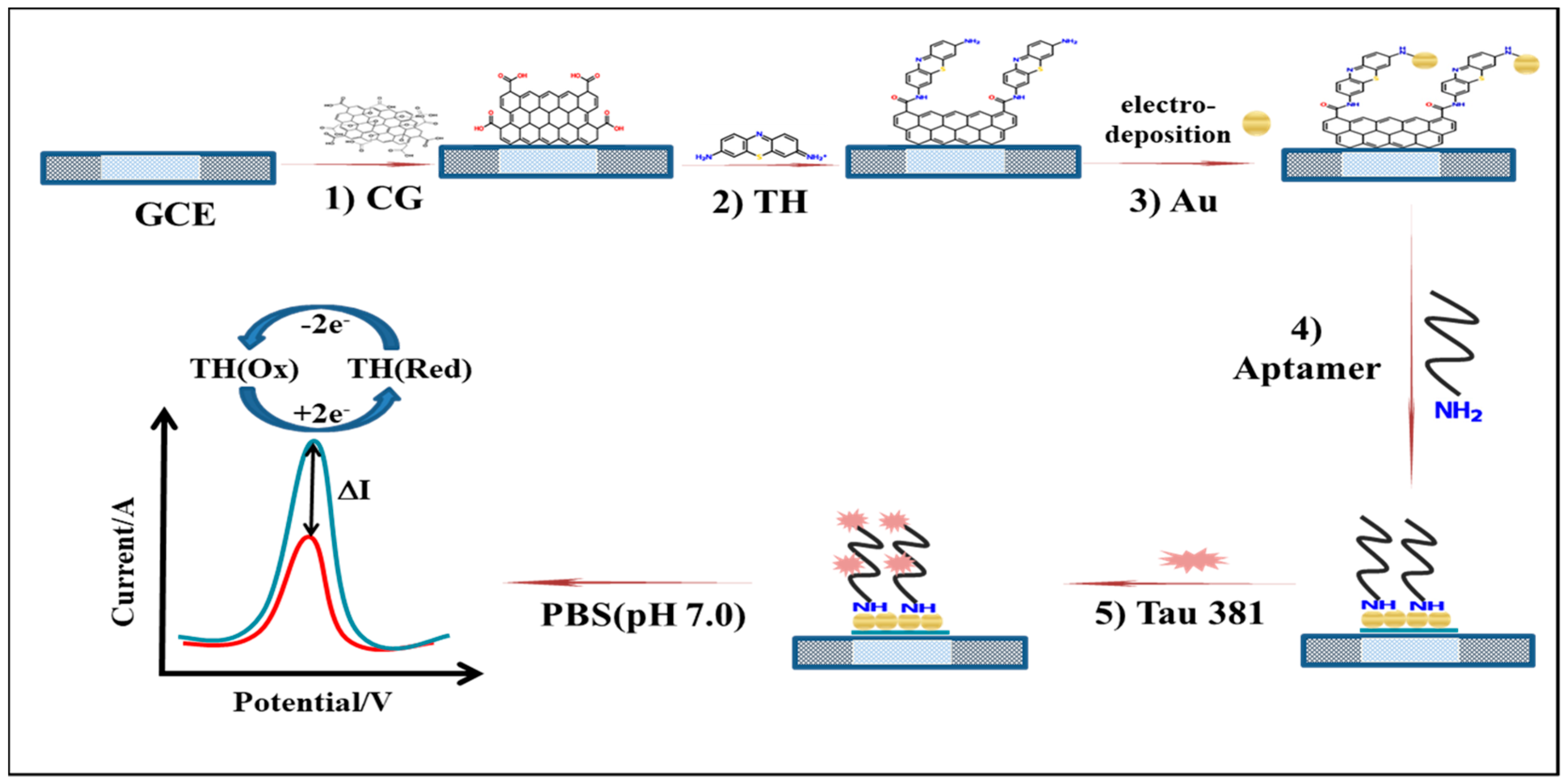
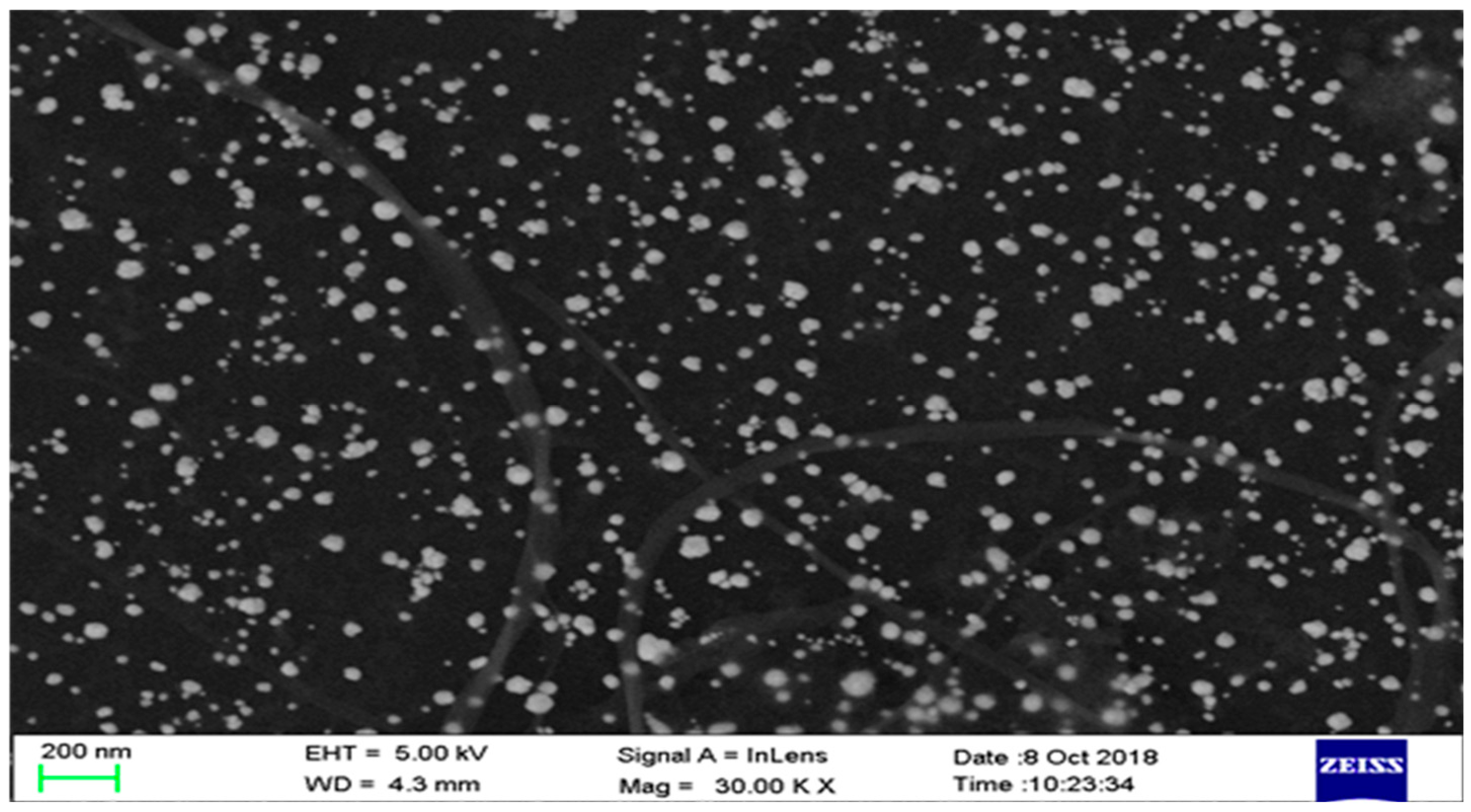
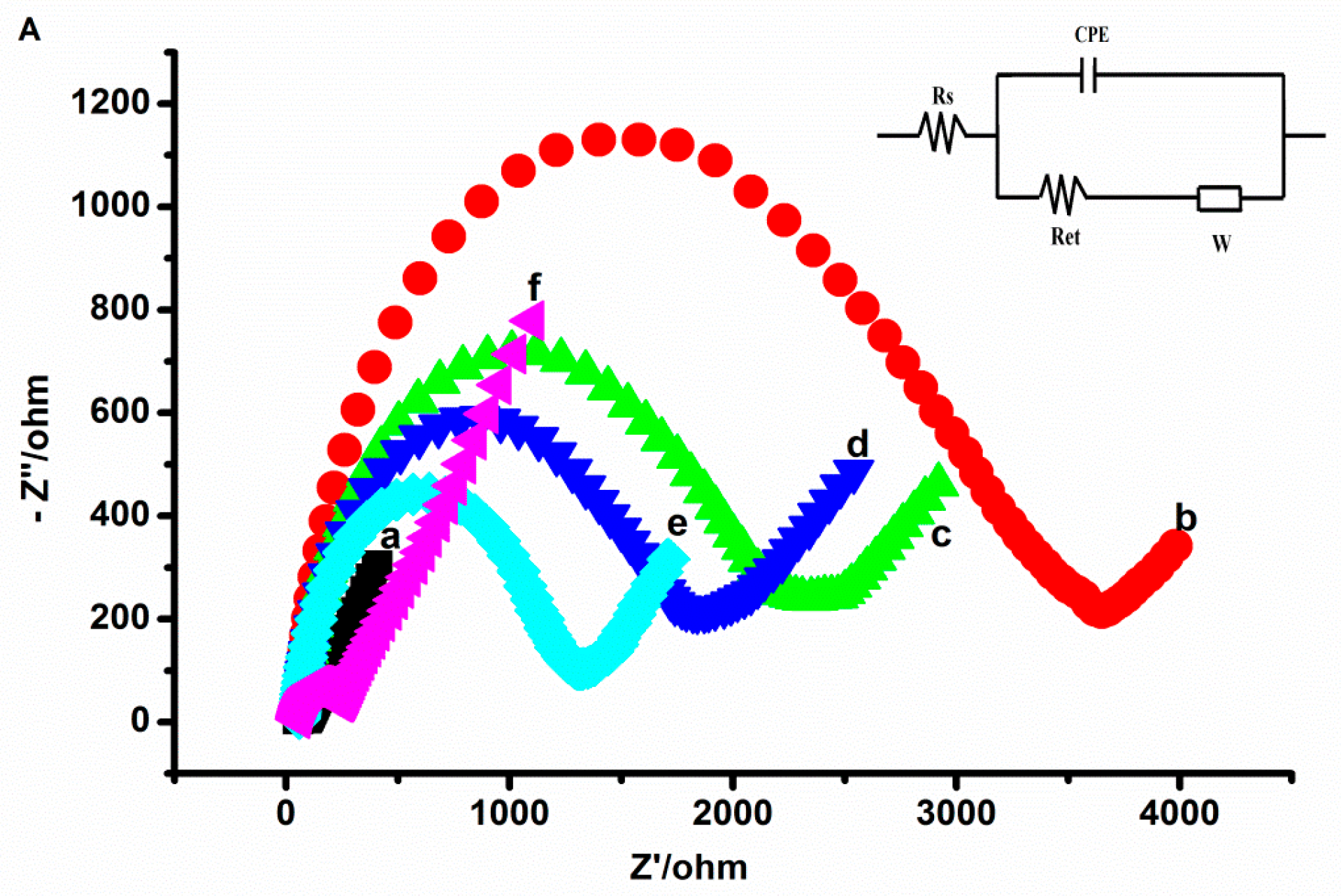
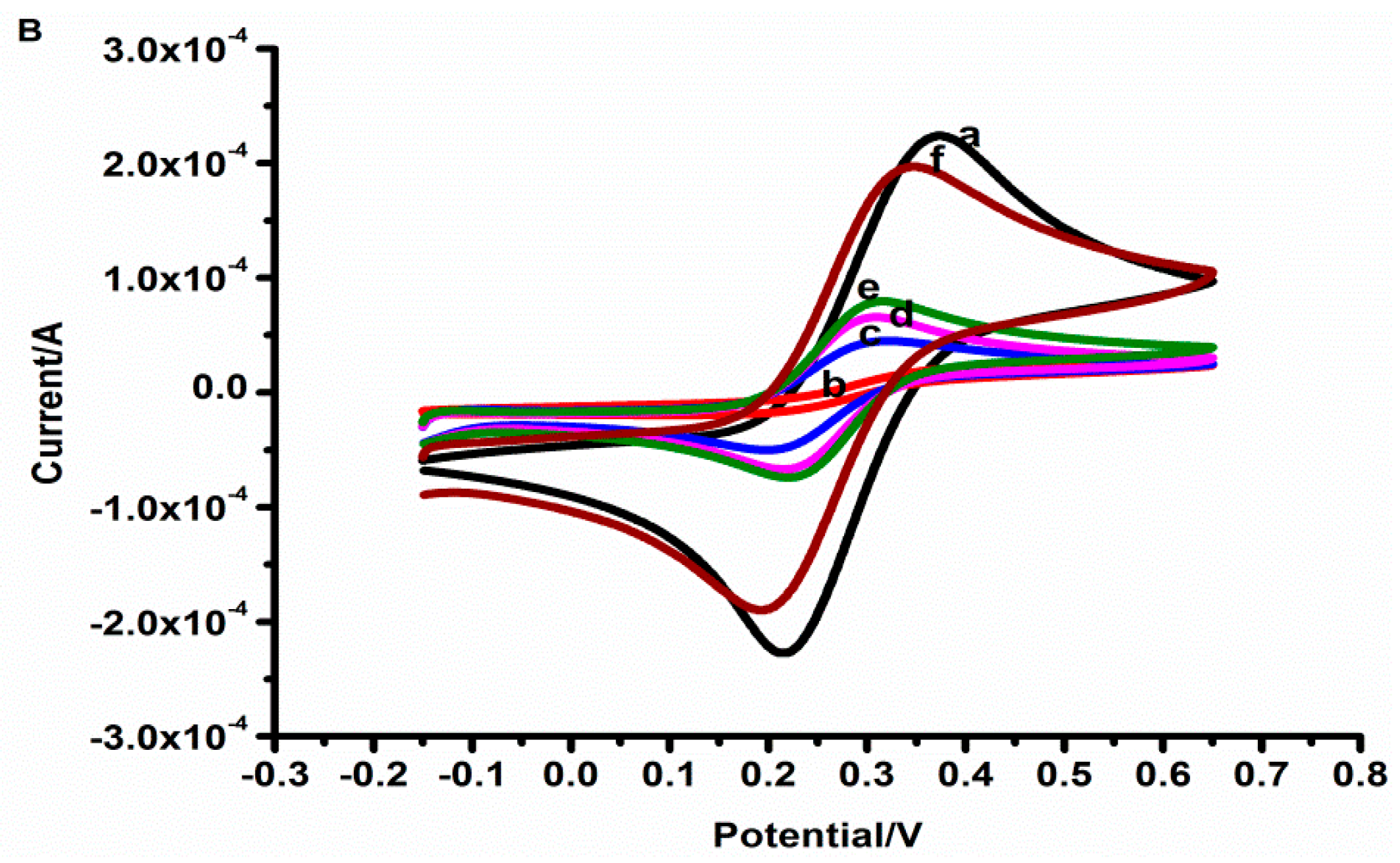

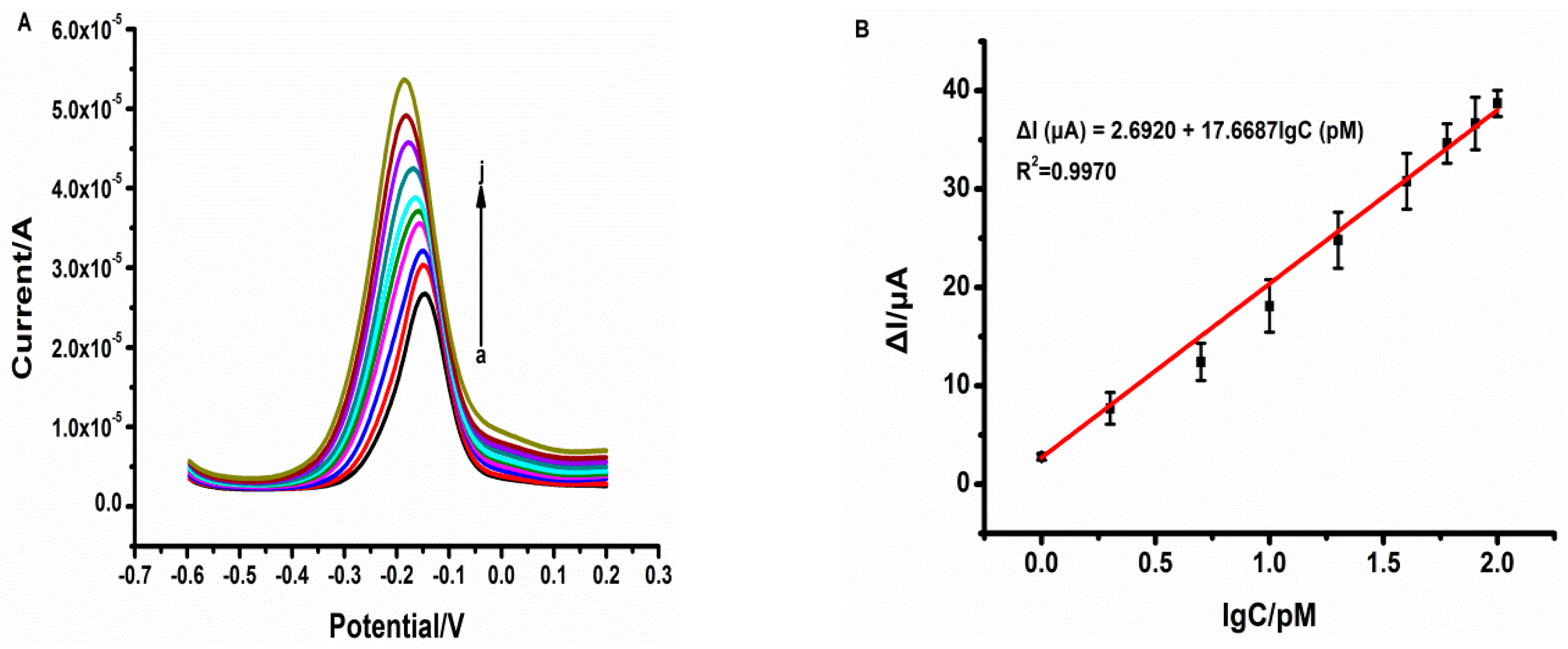
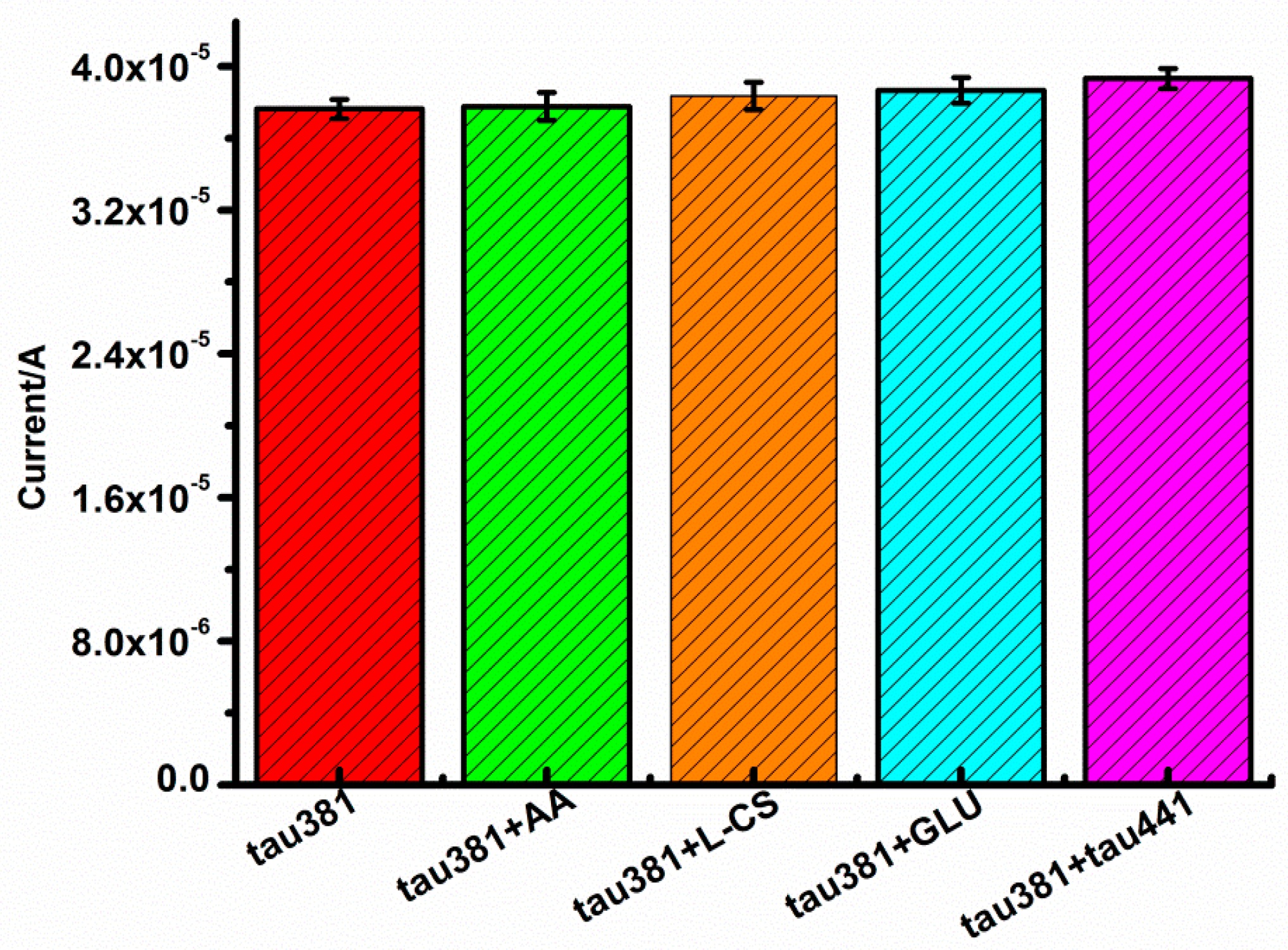
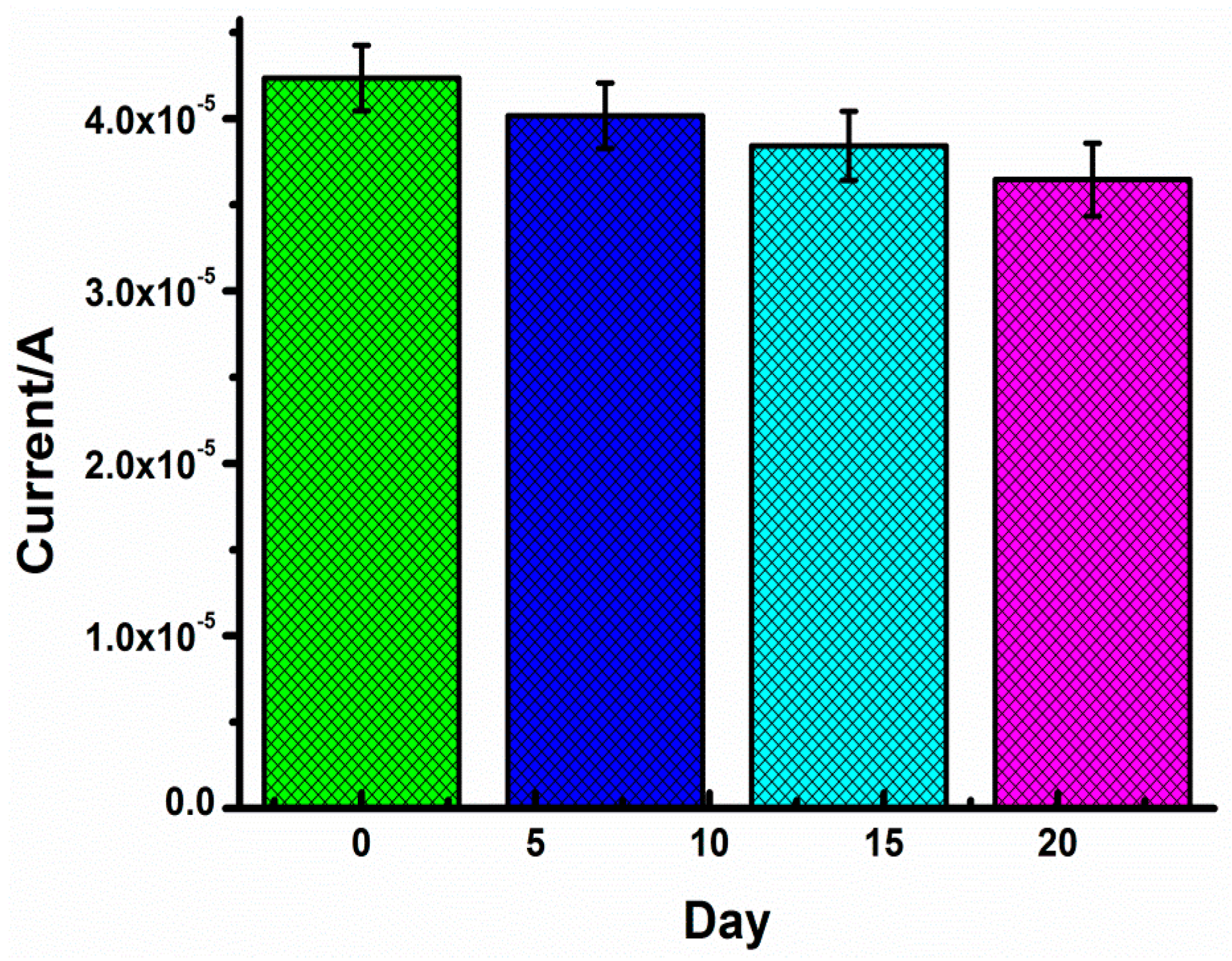
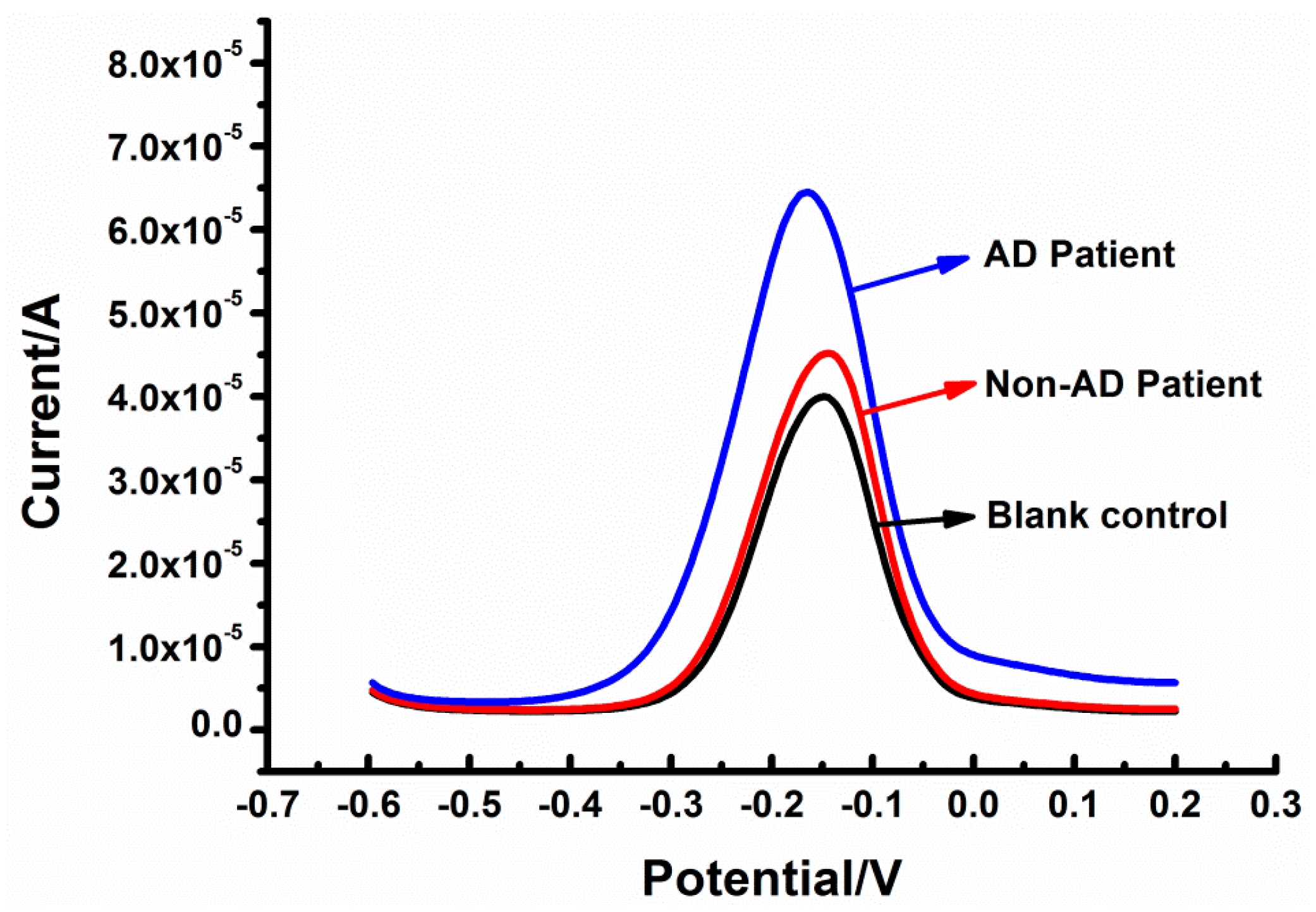
| Techniques | Modified | Linear Rang | LOD | Target | Ref. |
|---|---|---|---|---|---|
| Fluorescence | FAM/ssDNA | - | 28 nM | Tau441 | [10] |
| SPR | aptamer/tau/anti-tau/ MUA | 10–100 fM | 10 fM | Tau381 | [17] |
| tau/mAb/protein G | 0.01–100 ng/mL | 10 pg/mL | Tau441 | [18] | |
| tau/anti-tau/11-MUA | 10–2000 pg/mL | 2.4 pg/mL | T-tau | [19] | |
| Electrochemistry | tau/anti-tau/pPG/GO | 0.5–15.1 nM | 0.15 nM | T-tau | [13] |
| tau/anti-tau/protein G/ DTSSP | 10−14–10−7 M | 0.03 pM | Tau441 | [14] | |
| CS-Au-Aptamer/tau/anti-tau/MPA | 0.5–100.0 pM | 0.42 pM | Tau381 | [20] | |
| tau/tau | 0.2–1.0 μM | - | Tau441 | [15] | |
| tau/anti-tau/MPA- SAM | 103–105 pg/mL | - | T-tau | [16] |
| Sample No. | Initial Concentration (pM) | Add (pM) | Detection (pM) | Recovery (%) | RSDs (%) |
|---|---|---|---|---|---|
| 1 | 0.75 | 2.00 | 2.80, 2.77, 2.78, 2.72, 2.78 | 101.0 | 1.08 |
| 2 | 0.75 | 20.00 | 19.68, 22.03, 20.56, 20.89, 21.01 | 100.4 | 4.07 |
| 3 | 0.75 | 60.00 | 58.36, 59.36, 59.23, 60.66, 62.12 | 98.6 | 2.45 |
| Sample No. | Content Detected with the Aptasensor (Mean ± SD, pM) | Content Detected with ELISA Kit (Mean ± SD, pM) | |
|---|---|---|---|
| Non-AD Patient | 1 | 100 ± 6 | 115 ± 41 |
| 2 | 163 ± 58 | 128 ± 26 | |
| 3 | 520 ± 74 | 553 ± 31 | |
| 4 | 248 ± 62 | 274 ± 26 | |
| 5 | 269 ± 67 | 295 ± 38 | |
| AD Patient | 1 | 1778 ± 86 | 1833 ± 58 |
| 2 | 4022 ± 59 | 4057 ± 54 | |
| 3 | 3883 ± 61 | 3923 ± 42 | |
| 4 | 4612 ± 62 | 4730 ± 51 | |
| 5 | 3558 ± 55 | 3666 ± 45 |
© 2019 by the authors. Licensee MDPI, Basel, Switzerland. This article is an open access article distributed under the terms and conditions of the Creative Commons Attribution (CC BY) license (http://creativecommons.org/licenses/by/4.0/).
Share and Cite
Tao, D.; Shui, B.; Gu, Y.; Cheng, J.; Zhang, W.; Jaffrezic-Renault, N.; Song, S.; Guo, Z. Development of a Label-Free Electrochemical Aptasensor for the Detection of Tau381 and its Preliminary Application in AD and Non-AD Patients’ Sera. Biosensors 2019, 9, 84. https://doi.org/10.3390/bios9030084
Tao D, Shui B, Gu Y, Cheng J, Zhang W, Jaffrezic-Renault N, Song S, Guo Z. Development of a Label-Free Electrochemical Aptasensor for the Detection of Tau381 and its Preliminary Application in AD and Non-AD Patients’ Sera. Biosensors. 2019; 9(3):84. https://doi.org/10.3390/bios9030084
Chicago/Turabian StyleTao, Dan, Bingqing Shui, Yingying Gu, Jing Cheng, Weiying Zhang, Nicole Jaffrezic-Renault, Shizhen Song, and Zhenzhong Guo. 2019. "Development of a Label-Free Electrochemical Aptasensor for the Detection of Tau381 and its Preliminary Application in AD and Non-AD Patients’ Sera" Biosensors 9, no. 3: 84. https://doi.org/10.3390/bios9030084
APA StyleTao, D., Shui, B., Gu, Y., Cheng, J., Zhang, W., Jaffrezic-Renault, N., Song, S., & Guo, Z. (2019). Development of a Label-Free Electrochemical Aptasensor for the Detection of Tau381 and its Preliminary Application in AD and Non-AD Patients’ Sera. Biosensors, 9(3), 84. https://doi.org/10.3390/bios9030084






